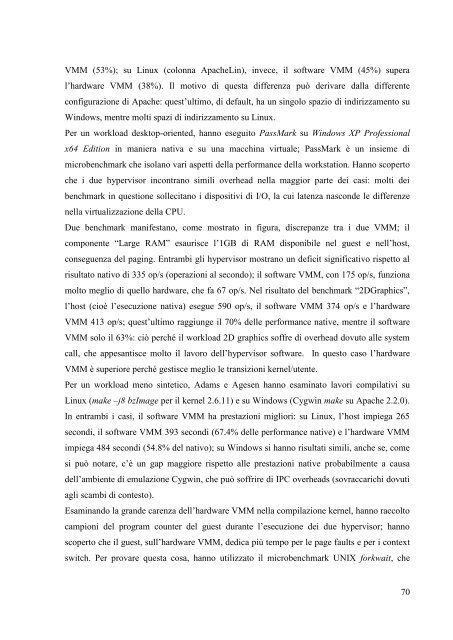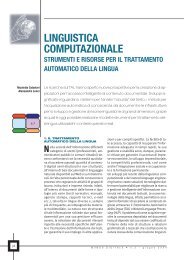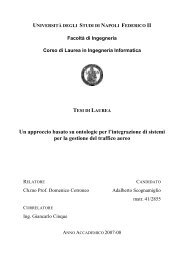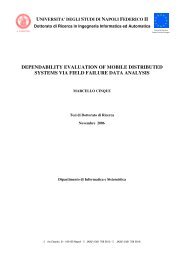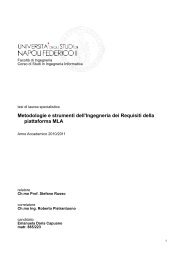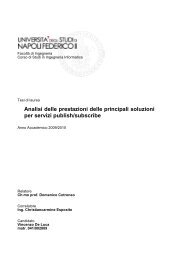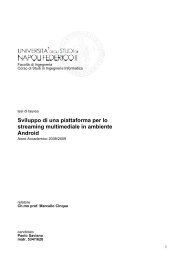Facoltà di Ingegneria Tesi di laurea ANALISI DELLE TECNOLOGIE ...
Facoltà di Ingegneria Tesi di laurea ANALISI DELLE TECNOLOGIE ...
Facoltà di Ingegneria Tesi di laurea ANALISI DELLE TECNOLOGIE ...
You also want an ePaper? Increase the reach of your titles
YUMPU automatically turns print PDFs into web optimized ePapers that Google loves.
VMM (53%); su Linux (colonna ApacheLin), invece, il software VMM (45%) supera<br />
l’hardware VMM (38%). Il motivo <strong>di</strong> questa <strong>di</strong>fferenza può derivare dalla <strong>di</strong>fferente<br />
configurazione <strong>di</strong> Apache: quest’ultimo, <strong>di</strong> default, ha un singolo spazio <strong>di</strong> in<strong>di</strong>rizzamento su<br />
Windows, mentre molti spazi <strong>di</strong> in<strong>di</strong>rizzamento su Linux.<br />
Per un workload desktop-oriented, hanno eseguito PassMark su Windows XP Professional<br />
x64 E<strong>di</strong>tion in maniera nativa e su una macchina virtuale; PassMark è un insieme <strong>di</strong><br />
microbenchmark che isolano vari aspetti della performance della workstation. Hanno scoperto<br />
che i due hypervisor incontrano simili overhead nella maggior parte dei casi: molti dei<br />
benchmark in questione sollecitano i <strong>di</strong>spositivi <strong>di</strong> I/O, la cui latenza nasconde le <strong>di</strong>fferenze<br />
nella virtualizzazione della CPU.<br />
Due benchmark manifestano, come mostrato in figura, <strong>di</strong>screpanze tra i due VMM; il<br />
componente “Large RAM” esaurisce l’1GB <strong>di</strong> RAM <strong>di</strong>sponibile nel guest e nell’host,<br />
conseguenza del paging. Entrambi gli hypervisor mostrano un deficit significativo rispetto al<br />
risultato nativo <strong>di</strong> 335 op/s (operazioni al secondo); il software VMM, con 175 op/s, funziona<br />
molto meglio <strong>di</strong> quello hardware, che fa 67 op/s. Nel risultato del benchmark “2DGraphics”,<br />
l’host (cioè l’esecuzione nativa) esegue 590 op/s, il software VMM 374 op/s e l’hardware<br />
VMM 413 op/s; quest’ultimo raggiunge il 70% delle performance native, mentre il software<br />
VMM solo il 63%: ciò perché il workload 2D graphics soffre <strong>di</strong> overhead dovuto alle system<br />
call, che appesantisce molto il lavoro dell’hypervisor software. In questo caso l’hardware<br />
VMM è superiore perché gestisce meglio le transizioni kernel/utente.<br />
Per un workload meno sintetico, Adams e Agesen hanno esaminato lavori compilativi su<br />
Linux (make –j8 bzImage per il kernel 2.6.11) e su Windows (Cygwin make su Apache 2.2.0).<br />
In entrambi i casi, il software VMM ha prestazioni migliori: su Linux, l’host impiega 265<br />
secon<strong>di</strong>, il software VMM 393 secon<strong>di</strong> (67.4% delle performance native) e l’hardware VMM<br />
impiega 484 secon<strong>di</strong> (54.8% del nativo); su Windows si hanno risultati simili, anche se, come<br />
si può notare, c’è un gap maggiore rispetto alle prestazioni native probabilmente a causa<br />
dell’ambiente <strong>di</strong> emulazione Cygwin, che può soffrire <strong>di</strong> IPC overheads (sovraccarichi dovuti<br />
agli scambi <strong>di</strong> contesto).<br />
Esaminando la grande carenza dell’hardware VMM nella compilazione kernel, hanno raccolto<br />
campioni del program counter del guest durante l’esecuzione dei due hypervisor; hanno<br />
scoperto che il guest, sull’hardware VMM, de<strong>di</strong>ca più tempo per le page faults e per i context<br />
switch. Per provare questa cosa, hanno utilizzato il microbenchmark UNIX forkwait, che<br />
70


